Victorian America’s Ice Delivery
Victorian America’s Ice Delivery
.

.
In Victorian Refrigerators (a.k.a. Icebox), I covered everything from proper construction of the in-home and commercial iceboxes to the years to the brands in competition, to proper storage of food and instructions from the manufacturers. I included an old-fashioned ice-box dessert recipe from a newspaper in the era. As promised, this article contains information about ice companies, ice delivery, proper construction of ice houses (to withstand summertime heat), and more (such as harvesting ice).
.
.
.
ICE HARVESTING
.
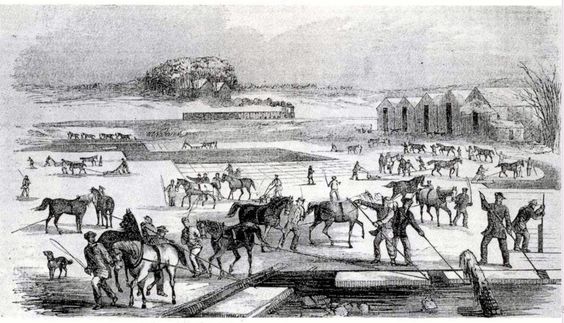
Vintage Illustration: Ice Harvesting drawing from mid-19th century: This 1852 drawing, from Gleason’s Drawing Room Companion, shows ice harvesting on Spy Pond in Arlington, Massachusetts. Image: from www.ForgottenNewEngland.com, via Pinterest.
.
See much more about the actual process of ice harvesting (cutting the ice and the whole process of storage) in another blog post article:
.
.
A FAMILY’S OWN ICE HOUSE
.
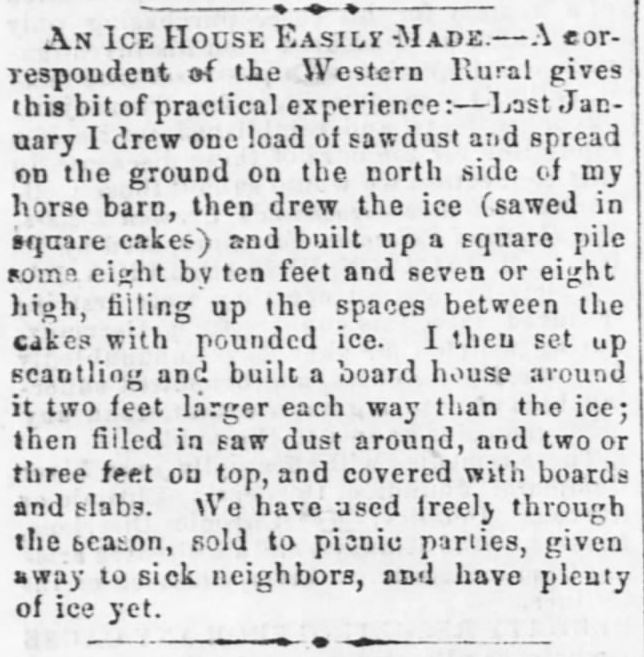
The Ebensburg Alleghenian of Ebensburg, Pennsylvania, on January 21, 1869.
.
.
Because this article from The Boston Weekly Globe, published February 2, 1881 is difficult to read in the digital scanned image, I’ve provided a word-for-word transcription (including lengthy paragraphs).
.

The Boston Weekly Globe on February 2, 1881.
.
THE ICE-HOUSE.
______________
How to Pack Ice–A Good and *Cheap Ice-House–General Notes.
.
Those who put up a small quantity of ice often have difficulty in packing the blocks closely together so that they will not melt when warm weather comes. No matter how much care is taken to saw the blocks square and true, they cannot be packed without leaving many large spaces between them. To overcome this difficulty we have tried for two years, with perfect success, the following: Suppose your ice-house is ten by twelve feet; leaving a space of one foot all around for sawdust, you will have a space eight by ten feet for ice.
Mark out upon the ice you wish to cut a rectangle eight by ten feet. Mark this both ways into blocks of any convenient size. Beginning at one corner, with a chisel into which a handle four feet long has been inserted, mark upon the first block, half an inch deep, the number 1, and to the right of this mark 2, 3, etc, respectively on the blocks of the first row. Beginning at the left of the second row, mark 6, 7, 8, etc., or whatever the numbers happen to be, and so continue until all are marked. They can be marked very quickly and easily.
Chop holes just outside of two of the sides of the rectangle, one opposite each line, in order to start the saw, and saw out the blocks each way. If the ice is not too thick, it may be sawed one way and broken the other. But sawing both ways makes neater work. Put the blocks in the ice-house the same way they stood in the pond, and they will fit together very nicely. If there should be any space between them fill with sawdust; pour water over the whole layer and it will freeze sold. Mark out the other layers so that each will break joints both ways with one below it.
It is not necessary that the blocks should be of uniform size, as each will have its own place in the layer. When all the ice is put in and frozen together, a foot of sawdust on the sides and eighteen inches on the top will keep it through the hottest summer weather. There is no need of an expensive ice-house. Our ice is stored in the corner of a shed. The sides of the shed form two sides of the ice-house. Studs are set up for the other two sides, and loose boards put up against them form the inside, as the sawdust is packed around the ice. In order to get the full benefit of the ice, a refrigerator or ice-box is necessary.
.
A Good and *Cheap Ice-House.
.
It is rather late in the season to talk about building an ice-house, but since the keeping of ice through hot weather is much less of a hard job than is commonly believed, and since water frozen in December is pretty sure to stay for some considerable time, we give the following brief directions for building a *cheap and available ice-house where greater expenditure would not be desirable:
Begin by piling up eight or ten loads of smooth blocks of ice, cut to a size that may be easily handled, under a shed or on the north side of a barn, and cover the whole with sawdust; over this put plenty of straw. Then plank up around the pile to keep all in place. Good drainage for the bottom and good ventilation for the top are both essential, and the first may be obtained by layering a double board or plank floor, held up from the ground by cross places, and the second by putting over the pile a sharp pitched roof, open at the ends.
The first trial may not be a perfect success; the cause of failure, if a failure is made, will be seen and understood, and the second attempt will show conclusively that the ice can be easily and cheaply saved through the entire summer months in any section of our country where ice will make a sufficient thickness to put up.
.
General Notes.
.
In answer to the several inquiries made of us we give the following essential requisites for keeping ice in small quantities for a family where only single boarding is used for the building. By observing these requisites we have never been out of ice, when stored in such a building, with only seven or eight tons stored for daily use through summer and autumn.
.
- Perfect drainage at the bottom, which may be effected by placing the ice on a ten-inch even stratum of sawdust, resting on a floor of narrow planks with cracks between them.
- The square blocks of ice made into a solid pile, with ten or eleven inches space on each side, to be filled compactly with sawdust and trodden down as the pile of ice goes up. If the filling is attempted after the ice pile is completed crevices and openings sufficient to ruin the whole will be left.
- Ten inches or a foot of sawdust on the top of the ice; to be drawn aside while taking up a piece in summer and immediately replaced.
- A free sweep of wind over this top stratum of sawdust through open windows under the projected eaves, or through an opening several inches or a foot wide all around.
.
~ The Boston Weekly Globe of Boston, Massachusetts, on February 2, 1881.
.
*Note: Throughout the Victorian era in United States newspapers, the use of the word “cheap” has a somewhat different connotation than today. Historically, “cheap” was used in a favorable, complimentary way, synonymous with affordable, value for my dollar, excellent price, better quality than I’m paying for, etc. I saw numerous newspaper advertisements from quality, expensive men’s clothiers listing end-of-season steep discounts on costly suits of clothes as “cheap prices”. I simply can’t see an effective marketing team calling their product cheap if doing so wasn’t in the best light.
.

.
.
RAILROAD ICE HOUSES to support refrigerator cars
.
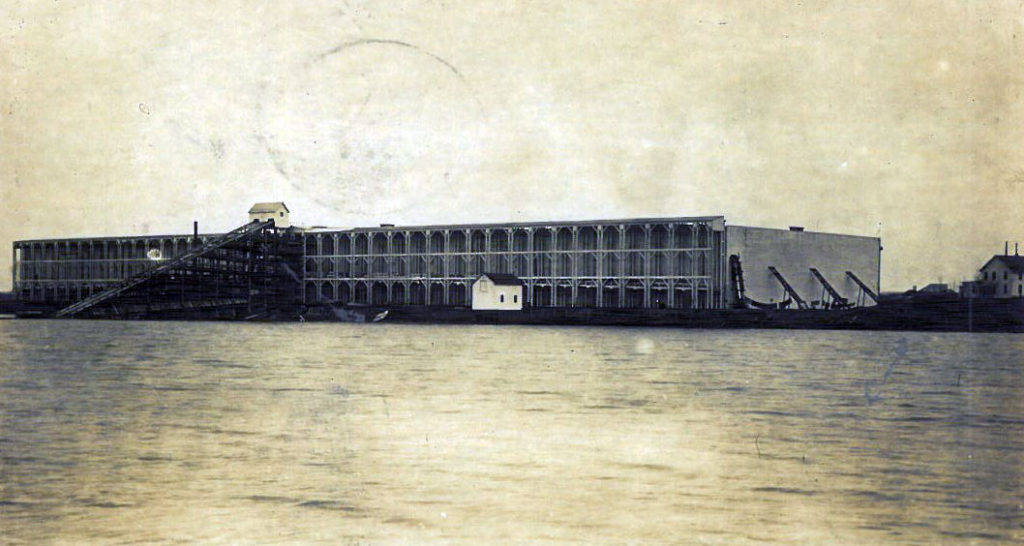
Swift Ice House, Image source: the Journal Star
.
As the railroads opened distant markets, the challenge of keeping meat and product fresh during shipment was met by filling insulated boxcars with ice. This called for vast amounts of ice at terminals like the South Omaha stockyards and supplemental points along the railroad.
.
In 1890, Swift & Co. obtained 150 acres of land on lakes northwest of Ashland. Adjacent to the lakes they built a 20-room, three-level, 192-by-685-foot ice house as well as a bunkhouse, barn and 10 other support buildings. Each room held 3,000 tons or a total of 60,000 tons of ice in what was termed “the largest storage capacity in the world.”
.
Ice harvesting from the lake, whose level was supplemented from Wahoo Creek, began when the ice was 8 inches thick. Horse-drawn ice saws cut slabs 20 by 40 inches which were then moved into the ice house by elevators powered by a steam engine, which also generated electricity.
.
About 20 men had year-round employment to load railroad cars arriving on a ¾-mile Union Pacific Railroad spur, while as many as 400 worked during the January and February harvest season and lived on site. During the summer the lake could be used recreationally for fishing and boating. [bold and underline added for emphasis]
.
.
![]()
.
ICE DELIVERY COMPANIES
.
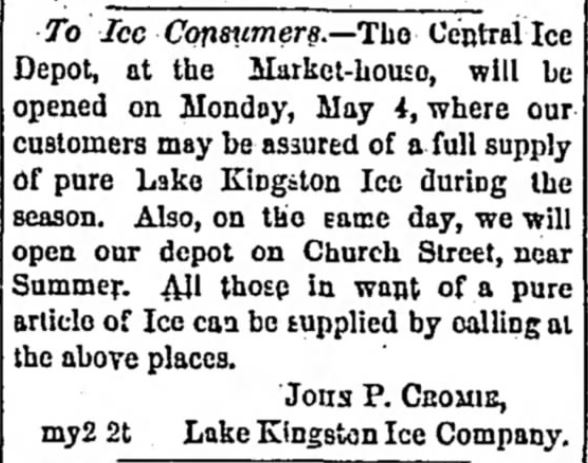
Ice Company opens for season. The Tennessean of Nashville, Tennessee on May 2, 1868.
.
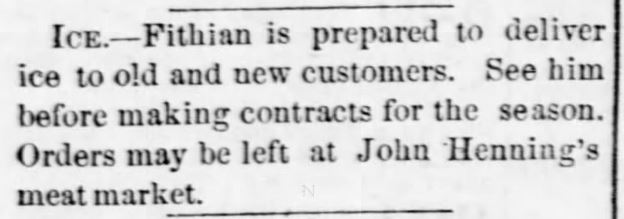
Fithian delivers ice by contract, advertised in Emporia Daily News of Emporia, Kansas on July 17, 1882.
.
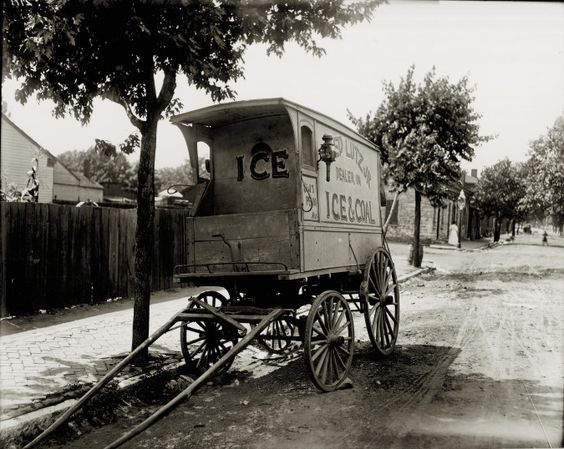
Fred Lutz, Jr. Ice Wagon. Fred Lutz, Jr., Dealer in Ice and Coal, 8417 Pennsylvania Avenue. Photograph by unknown, ca. 1909 Missouri History Museum Archives. Swekosky-MHS Collection n37764. Image courtesy of Missouri History Museum, via Pinterest. Note that the Lutz company delivered Ice AND Coal…perhaps in opposite seasons.
.
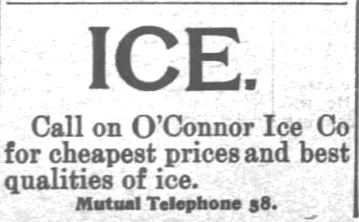
Fort Scott Daily Monitor of Fort Scott, Kansas, on October 1, 1897.
.
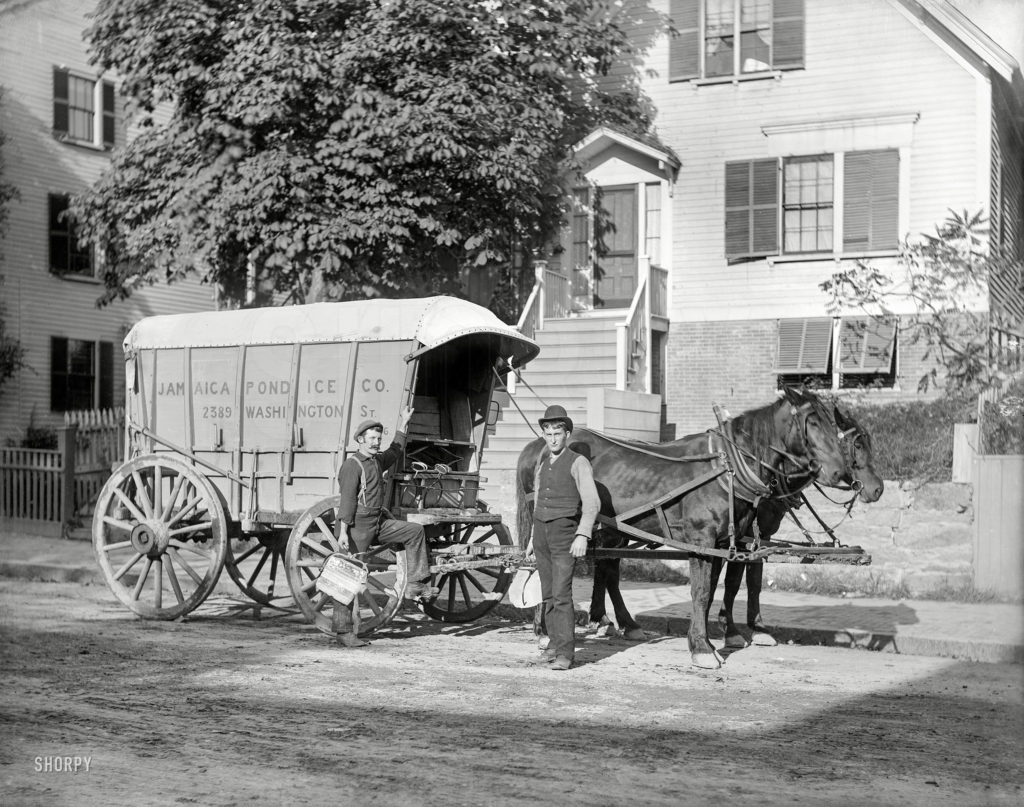
Boston Ice Delivery Wagon. Image via Pinterest from http://hdl.loc.gov/loc.pnp/ppmsca.49551
.

Cold Wave Ice Company advertised service in St. Louis Post-Dispatch of St. Louis, Missouri on April 1, 1888.
.
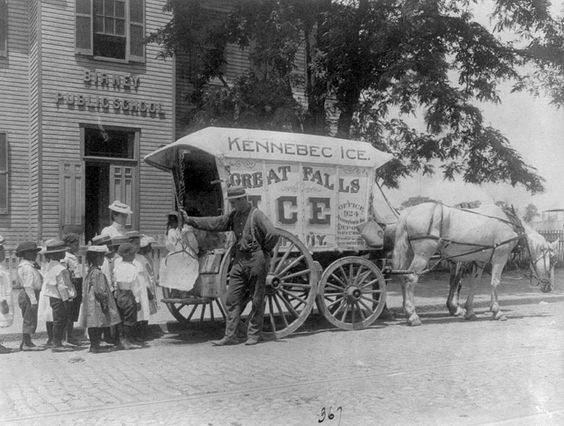
Ice Man Cometh: 1899 Black History Album. “1899–A horse-drawn wagon parked in front of a Birney Public School (Washington D.C.’s first public school for blacks). School children are lined up with their teacher behind the wagon as man shows them a large chunk of ice suspended by tongs.” Image: Pinterest
.
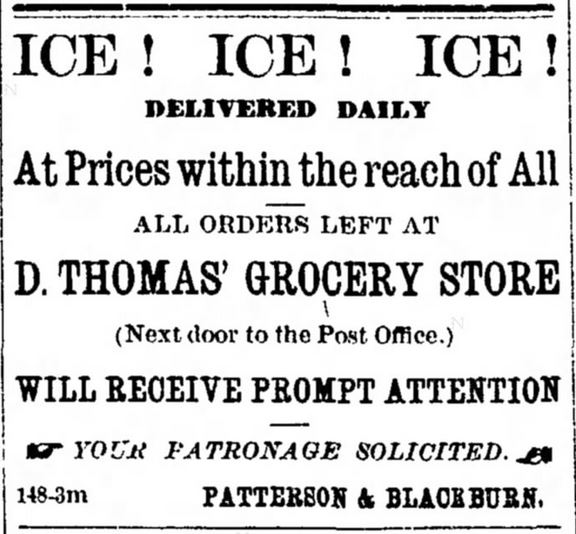
The Montana Standard of Butte, Montana, on October 16, 1879.
.
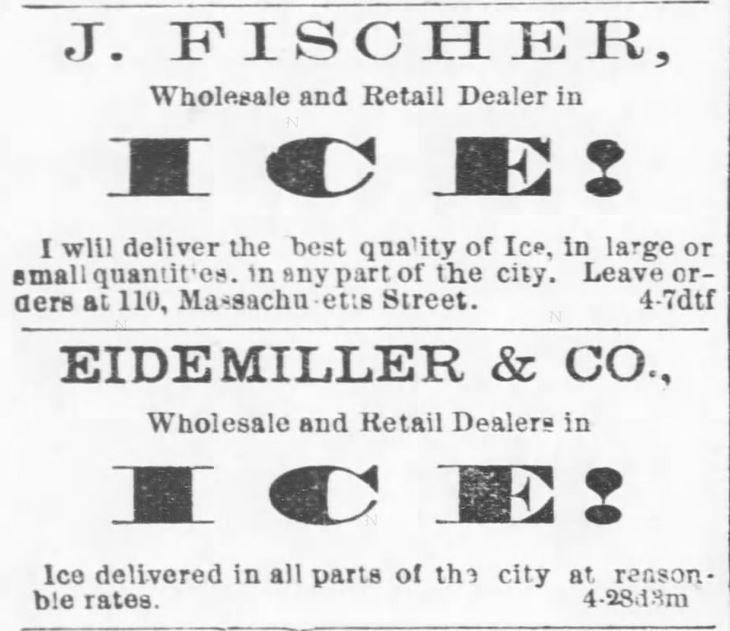
Two Ice companies (J. Fischer and Eidemiller & Co.) advertise in The Kansas Daily Tribune of Lawrence, Kansas on July 30, 1881.
.
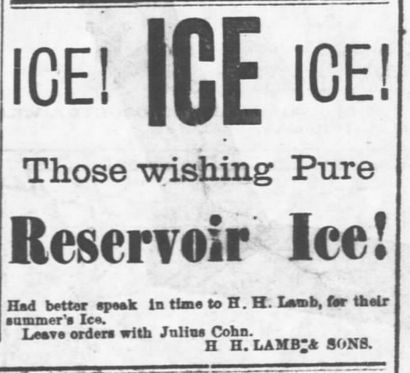
“ICE! Those wishing Pure Reservoir Ice!” Fort Scott Daily Monitor of Fort Scott, Kansas on May 13, 1883.
.
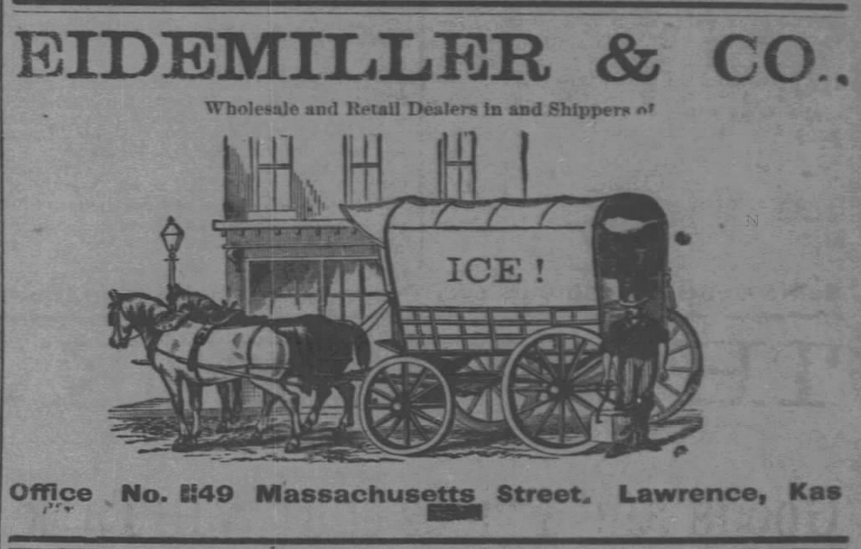
Illustrated advertisement for Eidemiller & Co. Ice Company from Lawrence Daily Journal of Lawrence, Kansas on July 27, 1884.
.
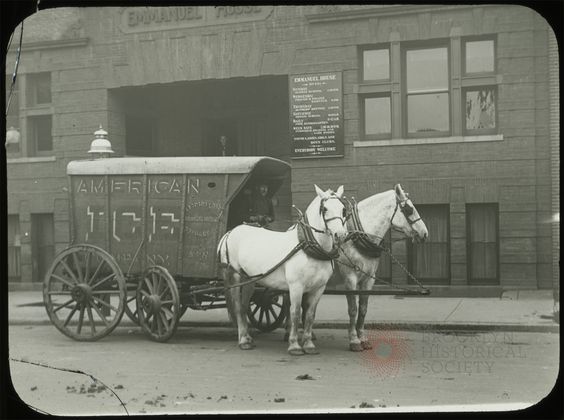
American Ice Company delivery wagon in Brooklyn circa 1900 when people were using 4 million tons of ice each year. An article in the Brooklyn Daily Eagle from July of 1872 details the uses of ice for everything from cooling down mint juleps, brandy smashes and claret punches at the saloon, to preserving meat in the butcher shops and preserving bodies at the morgues. Most of the ice brought in the city was natural ice from the Hudson and rivers in Maine. | Saved by Maria DiCoio on Pinterest from Brooklyn Historical Society.
.
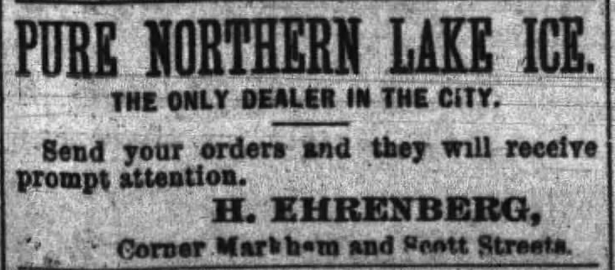
Pure Northern Lake Ice advertised in the Daily Arkansas Gazette of Little Rock, Arkansas on August 14, 1885.
.

“The ice man is getting ready to go his rounds and soon the yell of “Iscream” will be heard.” Morning Oregonian of Portland, Oregon, on April 5, 1885.
.
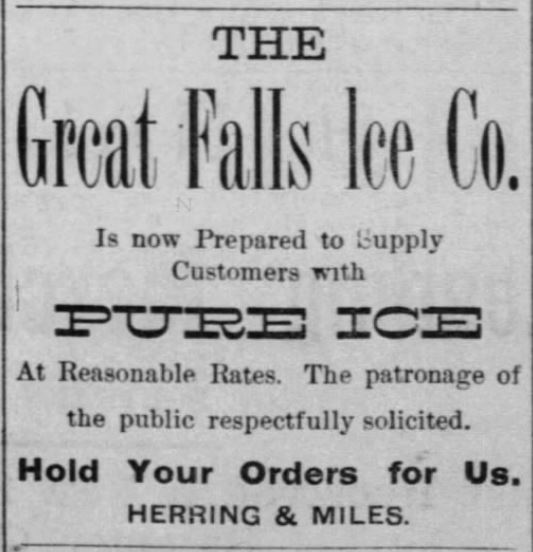
Great Falls ICE company advertises in Great Falls Tribune of Great Falls, Montana on April 27, 1889.
.
.
TOOLS FOR FAMILY USE with ICE
.
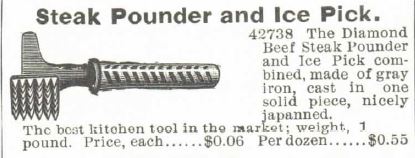
Steak Pounder and Ice Pick. Montgomery Ward Spring and Summer Catalog of 1895.
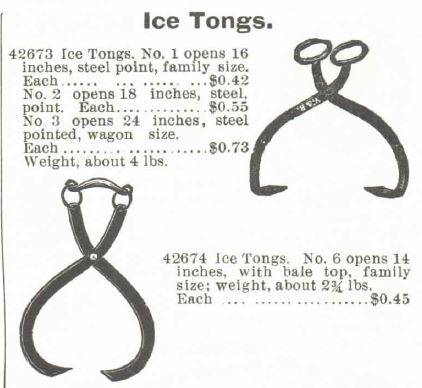
Ice Tongs in the Montgomery Ward Spring and Summer Catalog of 1895.
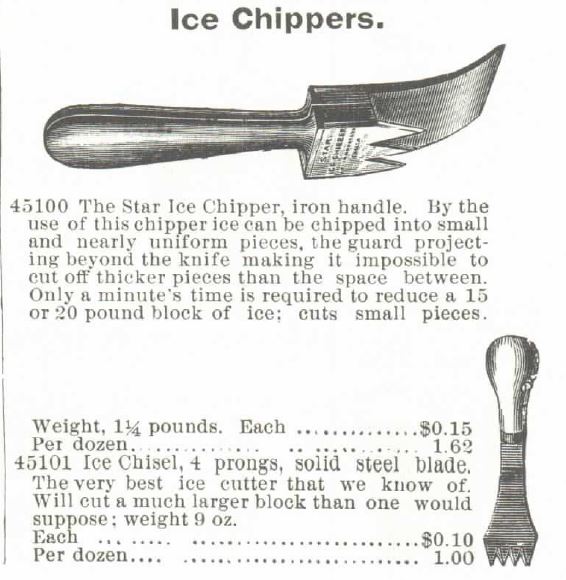
Ice Chippers. Household Devices. For sale in 1895 Montgomery Ward & Co. Catalogue, Spring and Summer.
.

.
Invitation
.
If YOU lived in the Victorian-era and needed ice for food management (and for your sweetened tea in the summertime), would you rather put in the work to harvest and store your own ice, or would you be one to find a way in the household budget to afford ice delivery?
Why? Please scroll down and comment.
.
Related Articles
.
.
Updated May 2022
Copyright © 2016 Kristin Holt LC
Victorian America’s Ice Delivery Victorian America’s Ice Delivery

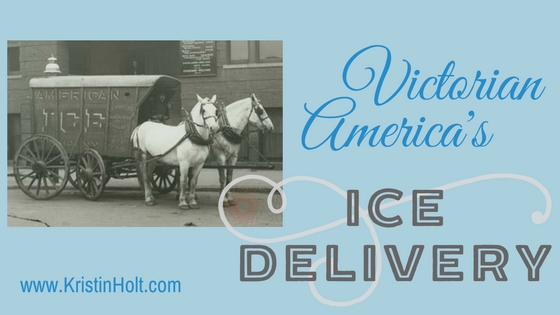





















Is there any way I could get a copy of this article? I’m putting together a display of ice harvesting for the MN Horse Expo next weekend.There will be a lot of draft horses there with demos on Fri. and Sat. of logging and farming and I thought it would fit well. I would, of course, credit you. Yes, I’m running perilously late. No, I’m not very computer savvy.
Hope to hear from you ASAP.
Thanks much,
Trina Joyce
Trina (and anyone else who may wish to contact me directly)–
Please don’t hesitate to use my “contact” page (see menu). Web pages are easy to cite, and that’s the way of things in today’s info-sharing environment.
I see the Minnesota Horse Expo is going on this weekend, April 27-29, 2018. So sorry to have missed you, Trina, and I hope your display went well.
Warm regards,
Kristin
I loved this research. The Ice delivery man needed to enter the home, do you have any research on social anxieties related to strapping young men delivering ice to the ladies of the house?
Hi Brenda–
I’m still chuckling! (Please–forgive me if the 2-dimensional world of text online has hidden your meaning… and you’re seriously researching.) I can imagine the strapping young man who delivers ice. And gives chips of the treat to the pack of kids following along in the streets. Have you read a hero who works as an Ice Man? How’s this: The Ice Man’s Bride. Or… The Ice Man Takes a Bride.
Thanks for stopping by!
Kristin